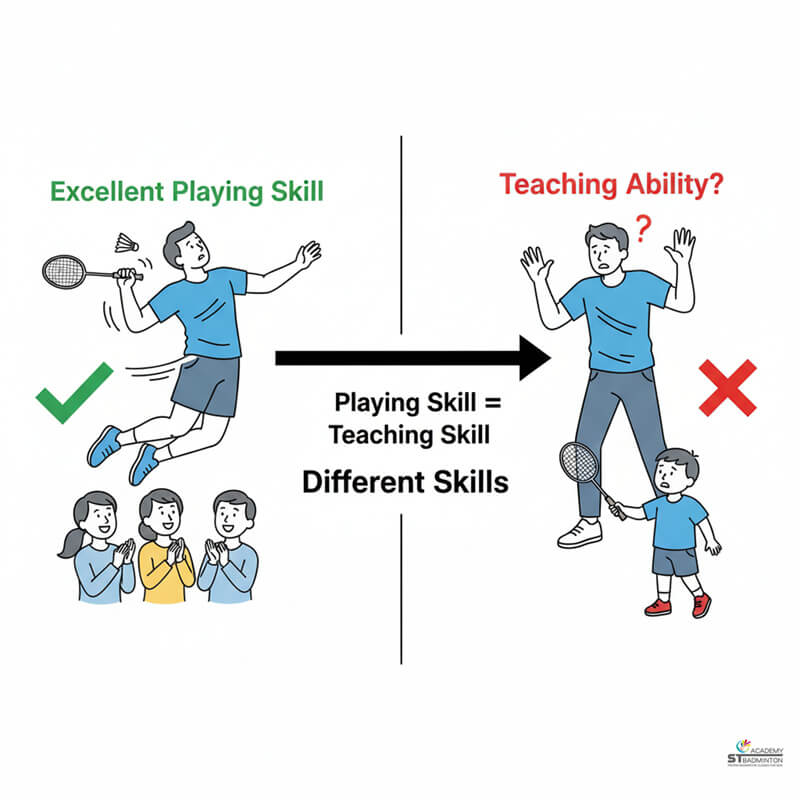The Best Badminton Arm Sleeves For Injury Prevention And Support Malaysia
An educational guide helping parents, adult players, and coaches understand when arm sleeves help, when they don’t, and when to seek professional advice in Kuala Lumpur.

Understanding Arm Sleeves
Why Players Use Arm Sleeves In Malaysia
As someone who works closely with badminton players across Kuala Lumpur, I regularly meet parents and adults who buy compression arm sleeves without fully understanding what they actually do. Many purchase them based on social media trends or because they saw a professional player wearing one. This guide helps you make calm, informed choices about badminton elbow support, not decisions driven by fear or marketing pressure. Families training in condos near LRT Sri Rampai, Kepong, Selayang, and Air Panas often ask about arm sleeves, and this resource addresses their most common questions. ST Badminton Academy Malaysia is a training academy focused on education and technique foundations, not on selling equipment to students or their families.
A Malaysian educational guide to safely choosing and using badminton arm sleeves for training in Kuala Lumpur areas.
The most common reasons players in KL buy compression arm sleeves include: seeking added comfort during long weekend sessions at Sunway Velocity or MyTOWN IKEA Cheras, wanting warmth in heavily air-conditioned halls, hoping for support after a full workday before evening matches near Jalan Genting Klang, or building confidence when returning from elbow discomfort. Some wear them during tournaments for psychological reassurance, while others use them daily during training. It’s important to differentiate between match use and training use. Wearing an arm sleeve during a tournament when you feel mentally prepared is different from relying on one every session to mask underlying technique problems or schedule overload.
Buying sleeves without addressing poor technique, excessive training volume, or inadequate rest is a common mistake. The sleeve may provide temporary comfort, but it does not fix the root cause. For instance, if a player develops tennis elbow from repeatedly hitting clears with incorrect wrist action, a compression sleeve might reduce immediate soreness but will not correct the swing mechanics. Over time, continuing to train incorrectly while depending on equipment can worsen the condition. Before purchasing any support equipment, players and parents should first assess training habits, warm-up routines, and stroke technique. When these fundamentals are sound, an arm sleeve can be a helpful addition, but never a replacement for proper training practices.
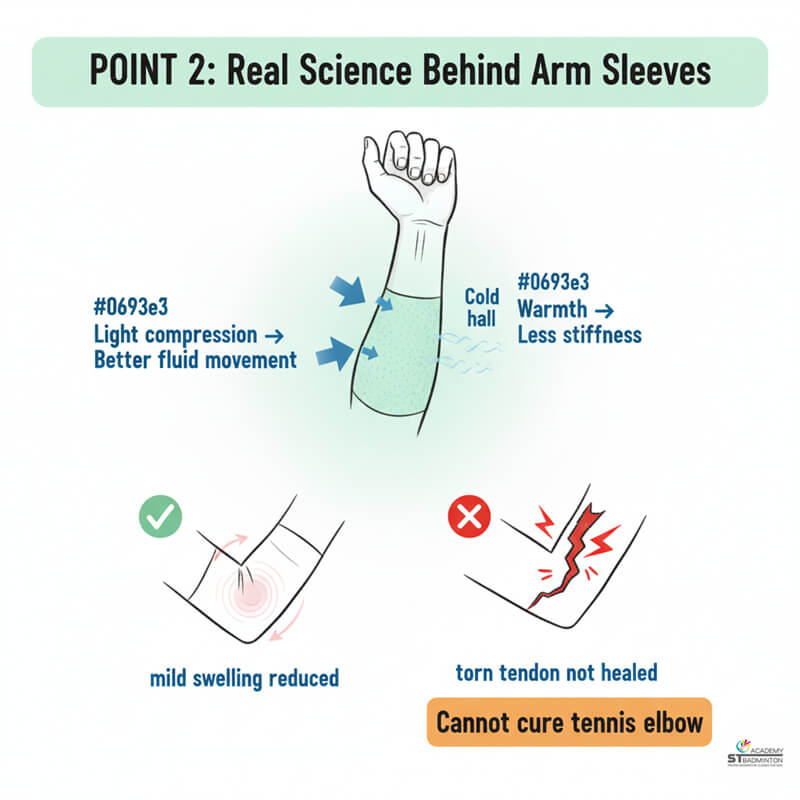
The Science Behind Support
How Arm Sleeves Actually Work
Compression arm sleeves work through several mechanisms, though their effects are often more modest than marketing claims suggest. Light, graduated compression may help with mild swelling control by promoting better fluid movement in the forearm. This can be beneficial after a long tournament or intense training session, but it does not repair damaged tissue. The compression also creates a sensation that some players interpret as stability or support, though this is largely a subjective feeling rather than true structural reinforcement of the elbow joint.
Warmth is another key function. Keeping the muscles and tendons of the forearm comfortably warm in heavily air-conditioned badminton halls around Setapak Central Mall or Titiwangsa Lake Gardens can reduce stiffness and maintain better blood flow. This is particularly useful for adults who train after work when muscles may already feel tight. However, warmth alone does not prevent injury if the player’s training load or technique is inappropriate. Some players also report improved proprioception when wearing a sleeve, meaning they feel more aware of where their arm is positioned during strokes. This can sometimes lead to better movement control, though this benefit is highly individual.
It is critical to understand what arm sleeves cannot do. They do not repair torn tendons, heal inflamed joints, or fix serious conditions like chronic tennis elbow or golfer’s elbow. These conditions, common in badminton from repetitive overhead clears and smashes, require proper medical assessment and treatment from a sports doctor or physiotherapist. An arm sleeve might make training slightly more comfortable in mild cases under professional guidance, but it is never a cure. Players experiencing persistent sharp pain, weakness when gripping the racket, or discomfort that worsens over weeks should seek qualified medical help rather than simply covering the issue with equipment. Relying on a sleeve to continue training through significant pain often leads to more serious injury that takes much longer to heal.
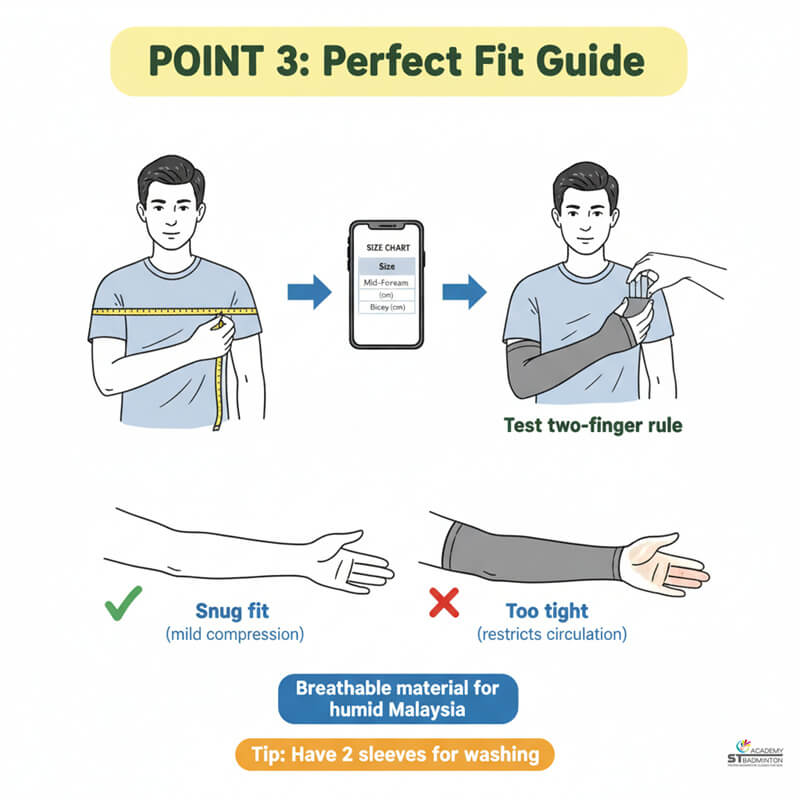
Fit and Material Selection
Choosing the Right Fit and Material
Getting the right fit is more important than brand or appearance. To measure properly, use a soft measuring tape to check the circumference of your mid-forearm and upper arm (bicep area). Most manufacturers provide size charts based on these measurements. A correctly fitted compression arm sleeve should feel snug but not restrictive. You should be able to slide two fingers under the fabric comfortably. If you cannot, or if the sleeve leaves deep marks on your skin, it is too tight and may impede circulation.
Signs that a sleeve is too tight include numbness in the fingers, a cold sensation in the hand, visible color change in the fingers (turning pale or bluish), or difficulty moving your wrist and elbow freely. These are serious warning signs. Remove the sleeve immediately if you experience any of these symptoms. On the other hand, a sleeve that is too loose provides no effective compression and will simply slide down your arm during play, which is both distracting and useless. For players training more than three to four times per week in areas like Wangsa Maju or Taman Maluri, having two sleeves allows you to wash one while using the other, maintaining hygiene and elasticity.
Material choice matters, especially in Malaysia’s hot, humid climate. Breathable, moisture-wicking fabrics help prevent excessive sweating and skin irritation during long sessions. Very thick or non-breathable materials may provide more warmth, which can be good in highly air-conditioned venues, but they can also cause overheating and discomfort during intense rallies. Look for materials that offer a balance of light compression, breathability, and durability. Avoid sleeves that are purely decorative or made from low-quality fabrics that lose elasticity after a few washes. Remember, the sleeve is a functional tool, not a fashion statement. Prioritize comfort, proper fit, and material quality over aesthetics or brand names seen on social media influencers.
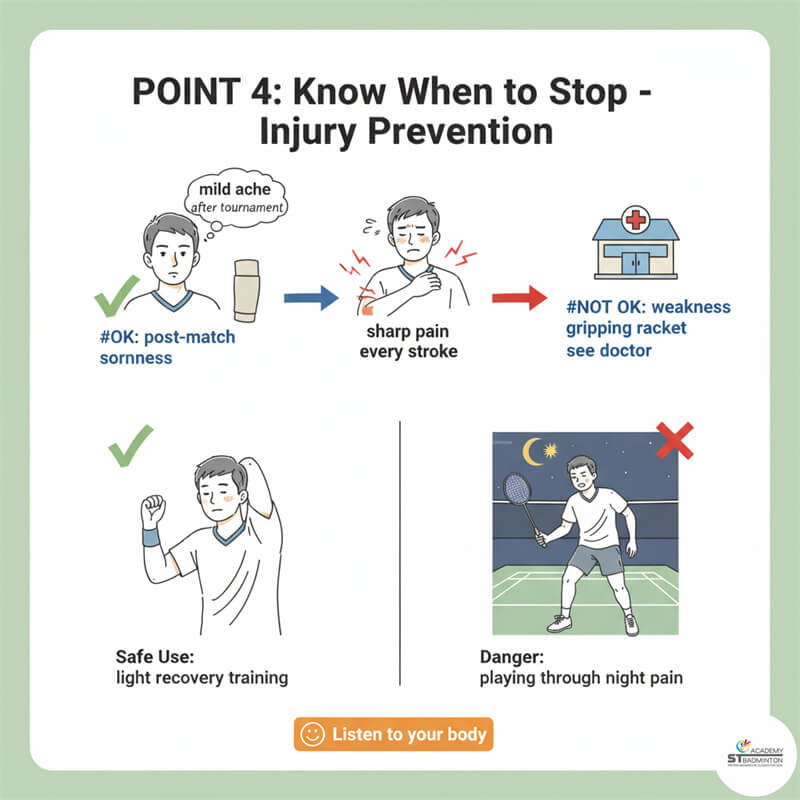
When To Use or Avoid
When a Sleeve Helps vs When to See a Professional
There are specific scenarios where a compression arm sleeve can be genuinely useful. For example, mild aching the day after a weekend tournament is a normal response to physical exertion, and wearing a sleeve for comfort during light activity or while commuting from LRT Maluri or MRT Cochrane can help manage this temporary soreness. Light swelling in the forearm after a particularly long training session might also benefit from gentle compression, especially when combined with adequate rest. Some players find that wearing a sleeve during recovery training, when returning gradually from an injury under professional guidance, provides psychological confidence and slight physical support as they rebuild strength.
However, there are clear situations where a sleeve is not enough. If you experience sharp, stabbing pain on every backhand stroke, this is not something to ignore or cover with equipment. Difficulty gripping your racket firmly, pain that wakes you up at night, or visible swelling that does not reduce with rest are all signs that you need medical assessment from a sports doctor or physiotherapist. These are not issues that a sleeve can fix. Continuing to train through these symptoms while relying on a sleeve often transforms a minor issue into a chronic problem that can sideline you for months. Persistent pain lasting more than one to two weeks, or discomfort that interferes with daily tasks like lifting objects or typing, should prompt you to seek qualified medical help immediately.
Parents and coaches in Kuala Lumpur should be especially watchful with younger players. While arm sleeves are rarely needed for junior players age 4 and above who train at appropriate volumes with proper technique, if a young player insists on wearing one or complains of consistent discomfort, this is a signal to review their training load and consult a professional rather than simply buying equipment. ST Badminton Academy Malaysia is a training academy focused on technique and schedule management, not a medical clinic, and we always recommend that players with persistent pain see a qualified healthcare provider before continuing intensive training.

Avoiding Common Mistakes
Common Mistakes With Arm Sleeves
One of the most frequent mistakes is using an arm sleeve as a substitute for proper warm-up and strength work. A sleeve does not prepare your muscles and tendons for activity. You still need to perform dynamic stretches, light forearm exercises, and gradual intensity progression before hard hitting. Skipping warm-up and relying on a sleeve for protection is a recipe for injury. Similarly, some players wear the same sleeve for months without washing it properly or checking whether the elastic has degraded. A sleeve that has lost its compression is functionally useless and may even bunch up during play, causing irritation or distraction.
Another serious error is wearing a sleeve to hide pain and continuing to train at full intensity. This approach transforms minor discomfort into major injury. If you feel you cannot train without a sleeve, that is a clear signal to reduce your training load, review your technique with a qualified coach, and possibly consult a healthcare professional. The sleeve should be a minor aid in specific situations, not a crutch that allows you to push through warning signs from your body. Buying sleeves based purely on social media trends or because a famous player wears one is also misguided. Professional athletes often have access to physiotherapists, customized equipment, and recovery protocols that recreational players do not. What works for them in their specific context may not be appropriate for your situation.
Parents of junior players should be particularly careful. If a child insists on wearing an arm sleeve, ask why. Is it because they are experiencing discomfort, or are they copying older players? For children age 4 and above and even older juniors, arm sleeves are rarely necessary. If a young player is experiencing arm pain, the first step is to assess their technique, reduce training volume if needed, and ensure adequate rest days. Adding equipment is not the solution to overtraining or poor mechanics. Teach children that equipment does not replace good habits, proper coaching, and listening to their bodies.

Self-Check Basics
Simple At-Home Checks and Warm-Up Ideas
Without offering medical diagnosis, players can perform simple awareness checks at home to notice early warning signs. Compare how your playing arm feels compared to your non-playing arm. Is there noticeable stiffness, a dull ache that persists even at rest, or reduced grip strength? These side-to-side differences are worth noting. Gentle forearm stretches can help maintain flexibility. Extend your arm, palm facing down, and use your other hand to gently pull your fingers back towards your body, holding for fifteen to twenty seconds. Repeat with the palm facing up. These stretches are safe for most people and can be done before and after training.
Light resistance band work can also support forearm health. Simple wrist curls and reverse wrist curls with a light band help maintain balanced strength. These exercises are suitable for small spaces in condos around Kepong, Selayang, or Air Panas, where families may not have access to large gyms. Keep sessions short and controlled, focusing on proper form rather than heavy resistance. If returning from injury, always start with shorter sessions and lower intensity, gradually building back up over weeks, not days. Rushing back to full training is a common cause of re-injury.
It is important to emphasize that these self-checks and stretches are for general awareness and maintenance, not for diagnosing or treating injury. If you notice persistent issues, consult a qualified healthcare professional. An arm sleeve might provide comfort during these gentle activities, but it should never be used to push through pain during actual badminton training. The goal is to build sustainable habits that support long-term health, not to find ways to keep training despite warning signs from your body.
Common Questions About Badminton Arm Sleeves in Malaysia
Educational answers to help parents and players in Kuala Lumpur make informed decisions about compression arm sleeves.
Do kids age 4 and above need arm sleeves?
Almost always no. Young children starting badminton training age 4 and above should focus entirely on building proper technique, learning fun movement patterns, and developing a love for the sport. Arm sleeves are rarely appropriate for this age group. Their training volume should be moderate, their sessions should emphasize skill development over intensity, and any equipment beyond a properly sized racket is unnecessary. For older juniors and teens, an arm sleeve might occasionally be useful if recommended by a physiotherapist during recovery from injury, but even then it is the exception, not the rule. If a young player complains of arm pain, the solution is to review training load and technique, not to buy equipment.
Can arm sleeves cure tennis elbow or golfer’s elbow?
No, compression arm sleeves cannot cure tennis elbow or golfer’s elbow. These conditions involve inflammation or micro-tears in the tendons around the elbow joint and require proper medical assessment and treatment. A sleeve may provide mild comfort and psychological reassurance during light activity, but it does not repair damaged tissue. Effective treatment typically involves rest, modifying training load, correcting technique, and sometimes physical therapy or medical intervention. Relying on a sleeve to continue intense training through these conditions usually makes them worse. If you experience persistent elbow pain, sharp discomfort during strokes, or weakness in grip strength, consult a sports doctor or physiotherapist rather than simply purchasing equipment.
How many hours a day is safe to wear a compression arm sleeve?
For most recreational players, wearing a compression arm sleeve during training sessions and for an hour or two afterward for recovery is reasonable. However, wearing a sleeve all day, every day is generally unnecessary and may lead to skin irritation or dependency. Your arm needs time without compression to maintain natural circulation and muscle function. If you feel you must wear a sleeve constantly to manage discomfort, this is a sign of an underlying issue that requires professional medical attention, not continuous equipment use. Always remove the sleeve if you notice numbness, tingling, color changes, or any circulation problems. Listen to your body, and use the sleeve as a targeted tool, not an all-day accessory.
What should I watch for when my child uses an arm sleeve?
If your child uses an arm sleeve, monitor them closely. Check that the sleeve is not too tight by ensuring you can slide two fingers comfortably under the fabric. Watch for signs of restricted circulation such as pale or cold fingers, numbness, or complaints of tingling. Ask your child regularly if the sleeve feels comfortable and whether they are experiencing any pain during training. Most importantly, if your child insists on wearing a sleeve, understand why. Are they copying older players, or are they experiencing discomfort? If it is the latter, reduce their training load and consult a coach or healthcare professional. A sleeve should never be a substitute for proper rest, technique correction, and age-appropriate training volume.
How do I choose between an elbow strap, full arm sleeve, or no support?
The choice depends on your specific needs and should ideally be guided by a healthcare professional if you are managing an injury. An elbow strap (forearm band) provides targeted compression just below the elbow and is often used for tennis elbow or golfer’s elbow under professional advice. A full arm sleeve offers broader compression and warmth for the entire forearm and can be useful for general comfort in cold environments or mild post-training soreness. However, for most healthy players with no injury history, no support is needed at all. Focus on proper warm-up, technique, training load management, and adequate rest. Only consider equipment when addressing a specific, identified need, and preferably after consulting a qualified coach or physiotherapist.
How do players in Kuala Lumpur balance training load, work, and recovery?
Adult players in Kuala Lumpur often train after long workdays, arriving at courts near Setapak, Sentul, or along MRR2 already fatigued. Balancing work, training, and recovery requires careful planning. Prioritize quality over quantity: two or three well-structured sessions per week with proper warm-up and cooldown are more beneficial than five rushed, intense sessions that leave you exhausted. Ensure adequate sleep, manage stress, and incorporate rest days into your schedule. An arm sleeve might provide minor comfort during recovery, but it is never a replacement for fundamental recovery practices. ST Badminton Academy Malaysia emphasizes schedule management and parent education alongside technique, helping families understand that sustainable progress comes from balanced training, not from pushing through fatigue with equipment.
Visual Guide to Safe Arm Sleeve Use
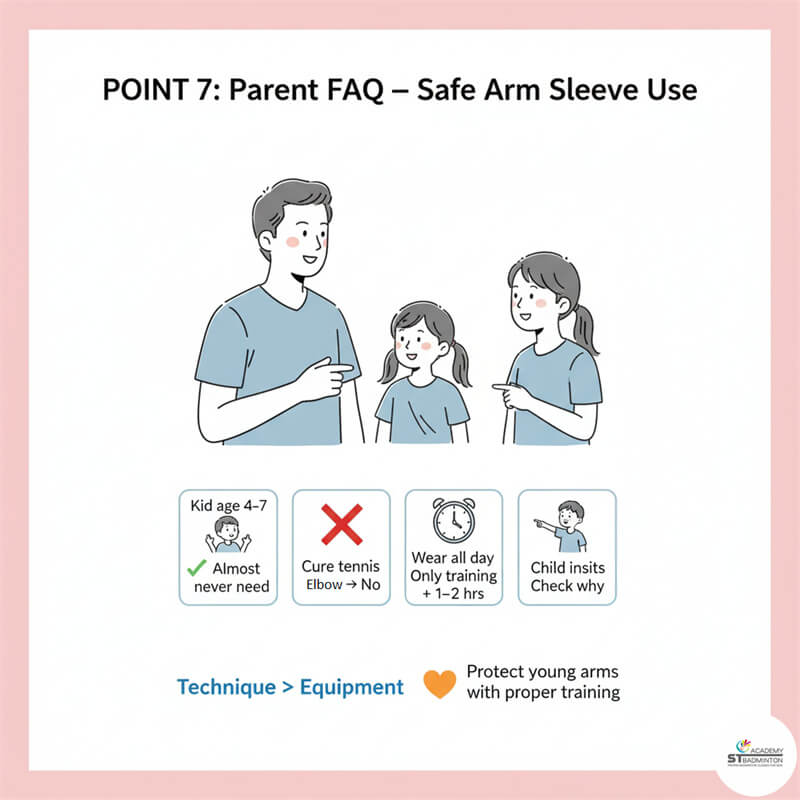



Foundation-First Training Prevents Injuries
Understanding arm sleeves is useful, but proper technique, appropriate training volume, and adequate rest are far more important for injury prevention. ST Badminton Academy Malaysia prioritizes teaching players and parents about sustainable training habits rather than relying on equipment to solve underlying problems.
| Decision Factor | Impulse Purchase From Social Media | Calm, Informed Choice EDUCATED |
|---|---|---|
| Main Motivation | Saw influencer wearing one, feels trendy, or bought out of fear after reading alarming posts about injuries. | Understands specific use cases: mild support during recovery, warmth in cold halls, or post-training comfort. |
| Fit Selection | Guesses size, orders based on color or brand name, often receives wrong fit causing discomfort. | Measures mid-forearm and bicep properly, checks size chart carefully, ensures snug but not restrictive fit. |
| Primary Focus | Aesthetics and brand logo visibility to look like professional players on court. | Function, comfort, breathability, and durability for Malaysian climate and actual training needs. |
| Injury Approach | Uses sleeve as a band-aid to continue training through pain without addressing root causes. | Consults physiotherapist, adjusts training load, fixes technique issues before relying on equipment. |
| For Children | Buys sleeve because other kids have one, even when child has no injury or discomfort. | Recognizes most kids do not need sleeves; focuses on proper technique, rest, and age-appropriate training volume. |
| Cost Consideration | Often overpays for branded sleeves marketed aggressively, believing price equals quality or protection. | Prioritizes proper fit and material quality at reasonable price; understands expensive does not mean better for individual needs. |
| Long-Term Strategy | Expects sleeve to solve all arm issues permanently without changing training habits or technique. | Views sleeve as one small support tool; prioritizes warm-up, strength work, rest, and coaching feedback. |
In-Person Badminton Training That Prioritizes Safety and Education
This guide helps you understand arm sleeves, but the most effective way to prevent injury is through proper training under experienced guidance. When you are ready to build safe, sustainable badminton skills, ST Badminton Academy Malaysia offers in-person badminton training in Malaysia for kids age 4 and above and adults. We do not offer online or virtual classes. Our programme emphasizes technique, warm-up routines, schedule management, and parent education before equipment. This is not a casual drop-in gym session; it is structured coaching in small groups for serious learners. Contact us to learn about class schedules and how to start training properly in Setapak, Wangsa Maju, and Cheras.



